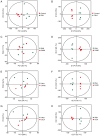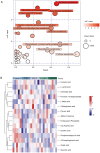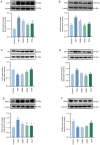Oroxylin A, a broad‑spectrum anticancer agent, relieves monocrotaline‑induced pulmonary arterial hypertension by inhibiting the Warburg effect in rats
- PMID: 39219283
- PMCID: PMC11391512
- DOI: 10.3892/mmr.2024.13319
Oroxylin A, a broad‑spectrum anticancer agent, relieves monocrotaline‑induced pulmonary arterial hypertension by inhibiting the Warburg effect in rats
Abstract
Pulmonary arterial hypertension (PAH) is a chronic and fatal disease characterized by pulmonary vascular remodeling, similar to the 'Warburg effect' observed in cancer, which is caused by reprogramming of glucose metabolism. Oroxylin A (OA), an active compound derived from Scutellaria baicalensis, which can inhibit glycolytic enzymes [hexokinase 2 (HK2), Lactate dehydrogenase (LDH), and pyruvate dehydrogenase kinase 1 (PDK1) by downregulating aerobic glycolysis to achieve the treatment of liver cancer. To the best of our knowledge, however, the impact of OA on PAH has not been addressed. Consequently, the present study aimed to evaluate the potential protective role and mechanism of OA against PAH induced by monocrotaline (MCT; 55 mg/kg). The mean pulmonary artery pressure (mPAP) was measured using the central venous catheter method; HE and Masson staining were used to observe pulmonary artery remodeling. Non‑targeted metabolomics was used to analyze the metabolic pathways and pathway metabolites in MCT‑PAH rats. Western Blot analysis was employed to assess the levels of glucose transporter 1 (Glut1), HK2), pyruvate kinase (PK), isocitrate dehydrogenase 2 (IDH2), pyruvate dehydrogenase kinase 1(PDK1), and lactate dehydrogenase (LDH) protein expression in both lung tissue samples from MCT‑PAH rats. The results demonstrated that intragastric administration of OA (40 and 80 mg/kg) significantly decreased mPAP from 43.61±1.88 mmHg in PAH model rats to 26.51±1.53 mmHg and relieve pulmonary artery remodeling. Untargeted metabolomic analysis and multivariate analysis indicated abnormal glucose metabolic pattern in PAH model rats, consistent with the Warburg effect. OA administration decreased this effect on the abnormal glucose metabolism. The protein levels of key enzymes involved in glucose metabolism were evaluated by western blotting, which demonstrated that OA could improve aerobic glycolysis and inhibit PAH by decreasing the protein levels of Glut1, HK2, LDH, PDK1 and increasing the protein levels of PK and IDH2. In conclusion, OA decreased MCT‑induced PAH in rats by reducing the Warburg effect.
Keywords: Warburg effect; glycolysis; metabolomics; oroxylin A; pulmonary arterial hypertension.
Conflict of interest statement
The authors declare that they have no competing interests.
Figures





References
-
- Spiekerkoetter E, Goncharova EA, Guignabert C, Stenmark K, Kwapiszewska G, Rabinovitch M, Voelkel N, Bogaard HJ, Graham B, Pullamsetti SS, Kuebler WM. Hot topics in the mechanisms of pulmonary arterial hypertension disease: Cancer-like pathobiology, the role of the adventitia, systemic involvement and right ventricular failure. Pulm Circ. 2019;9:2045894019889775. doi: 10.1177/2045894019889775. - DOI - PMC - PubMed
MeSH terms
Substances
LinkOut - more resources
Full Text Sources
Miscellaneous

